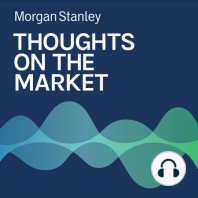3 min listen

The Gap Between Corporate Haves and Have-Nots
The Gap Between Corporate Haves and Have-Nots
ratings:
Length:
4 minutes
Released:
Feb 26, 2024
Format:
Podcast episode
Description
Our Chief U.S. Equity Strategist reviews how the unusual mix of loose fiscal policy and tight monetary policy has benefited a small number of companies – and why investors should still look beyond the top five stocks.----- Transcript -----Welcome to Thoughts on the Market. I'm Mike Wilson, Morgan Stanley’s CIO and Chief US Equity Strategist. Along with my colleagues bringing you a variety of perspectives, today I'll be talking about the investment implications of the unusual policy mix we face.It's Monday, February 26th at 12pm in New York. So let’s get after it.Four years ago, I wrote a note entitled, The Other 1 Percenters, in which I discussed the ever-growing divide between the haves and have-nots. This divide was not limited to consumers but also included corporates as well. Fast forward to today, and it appears this gap has only gotten wider.Real GDP growth is similar to back then, while nominal GDP growth is about 100 basis points higher due to inflation. Nevertheless, the earnings headwinds are just as strong despite higher nominal GDP – as many companies find it harder to pass along higher costs without damaging volumes. As a result, market performance is historically narrow. With the top five stocks accounting for a much higher percentage of the S&P 500 market cap than they did back in early 2020. In short, the equity market understands that this economy is not that great for the average company or consumer but is working very well for the top 1 per cent. In my view, the narrowness is also due to a very unusual mix of loose fiscal and tight monetary policy. Since the pandemic, the fiscal support for the economy has run very hot. Despite the fact we are operating in an extremely tight labor market, significant fiscal spending has continued.In many ways, this hefty government spending may be working against the Fed. And could explain why the economy has been slow to respond to generationally aggressive interest rate hikes. Most importantly, the government’s heavy hand appears to be crowding out the private economy and making it difficult for many companies and individuals. Hence the very narrow performance in stocks and the challenges facing the average consumer. The other policy variable at work is the massive liquidity being provided by various funding facilities – like the reverse repo to pay for these deficits. Since the end of 2022, the reverse repo has fallen by over $2 trillion. It’s another reason that financial conditions have loosened to levels not seen since the federal funds rate was closer to 1 per cent. This funding mechanism is part of the policy mix that may be making it challenging for the Fed’s rate hikes to do their intended work on the labor market and inflation. It may also help explain why the Fed continues to walk back market expectations about the timing of the first cut and perhaps the number of cuts that are likely to continue this year. Higher interest rates are having a dampening effect on interest-rate-sensitive businesses like housing and autos as well as low to middle income consumers. This is exacerbating the 1 percenter phenomena and helps explain why the market’s performance remains so stratified. For many businesses and consumers, rates remain too high. However, the recent hotter than expected inflation reports suggest the Fed may not be able to deliver the necessary rate cuts for the markets to broaden out – at least until the government curtails its deficits and stops crowding out the private economy. Parenthetically, the funding of fiscal deficits may be called into question by the bond market when the reverse repo runs out later this year. Bottom line: despite investors' desire for the equity market to broaden out, we continue to recommend investors focus on high-quality growth and operational efficiency factors when looking for stocks outside of the top five which appear to be fully priced. Thanks for listening. Subscribe to Thoughts on the Market on Apple Podcasts, or whereve
Released:
Feb 26, 2024
Format:
Podcast episode
Titles in the series (100)
Mike Wilson: Are U.S. Economic Indicators Flashing Yellow? by Thoughts on the Market